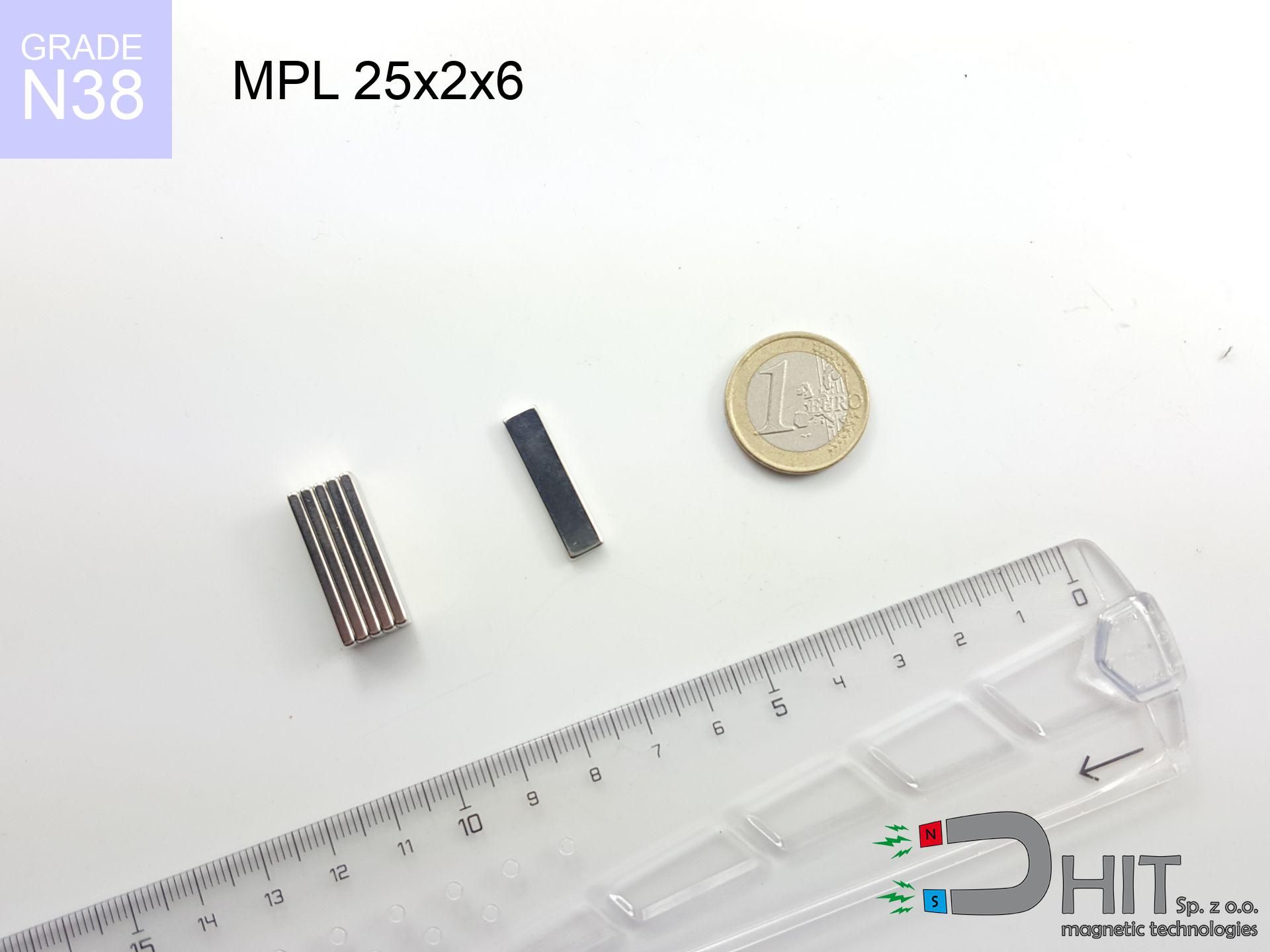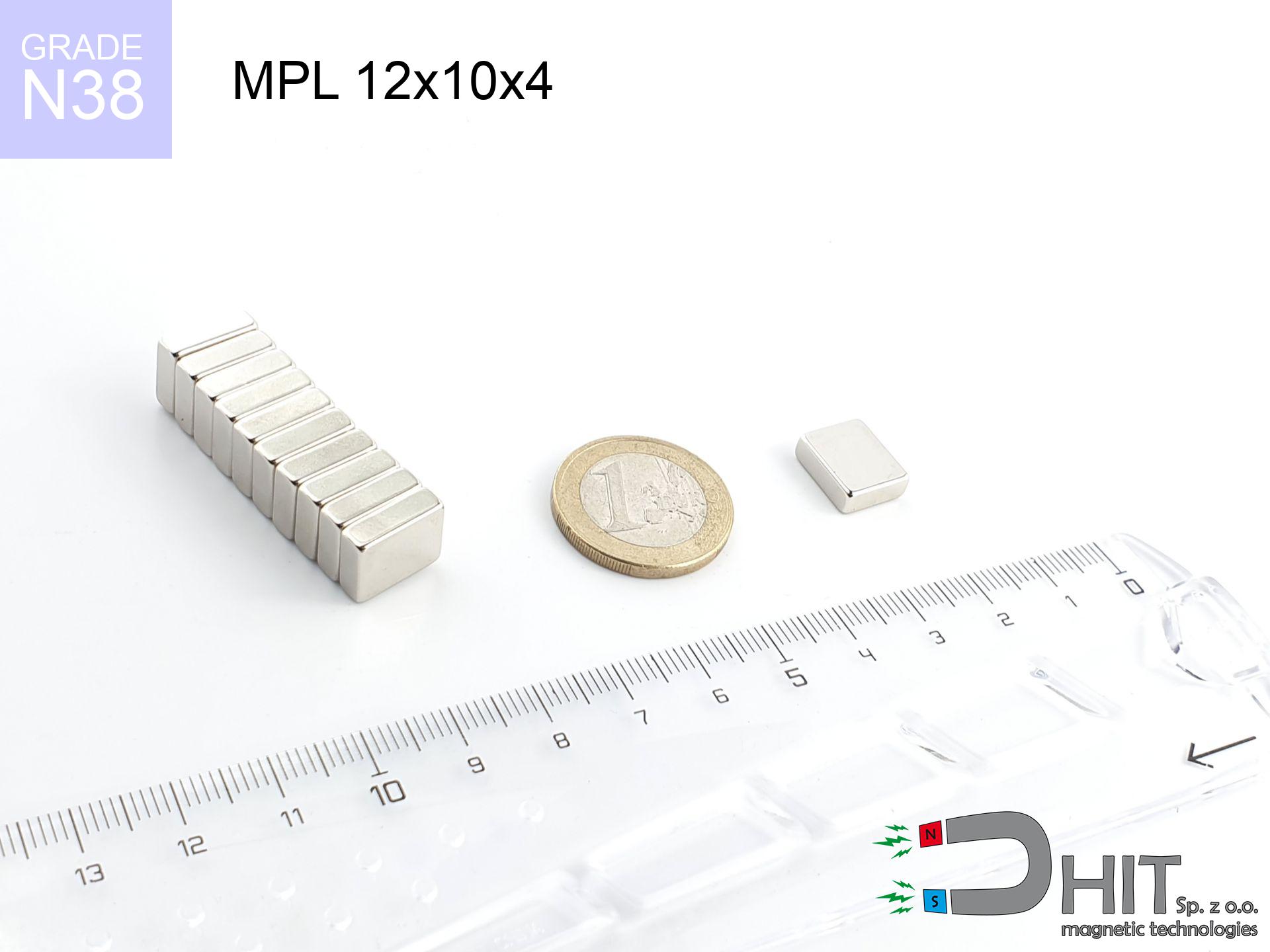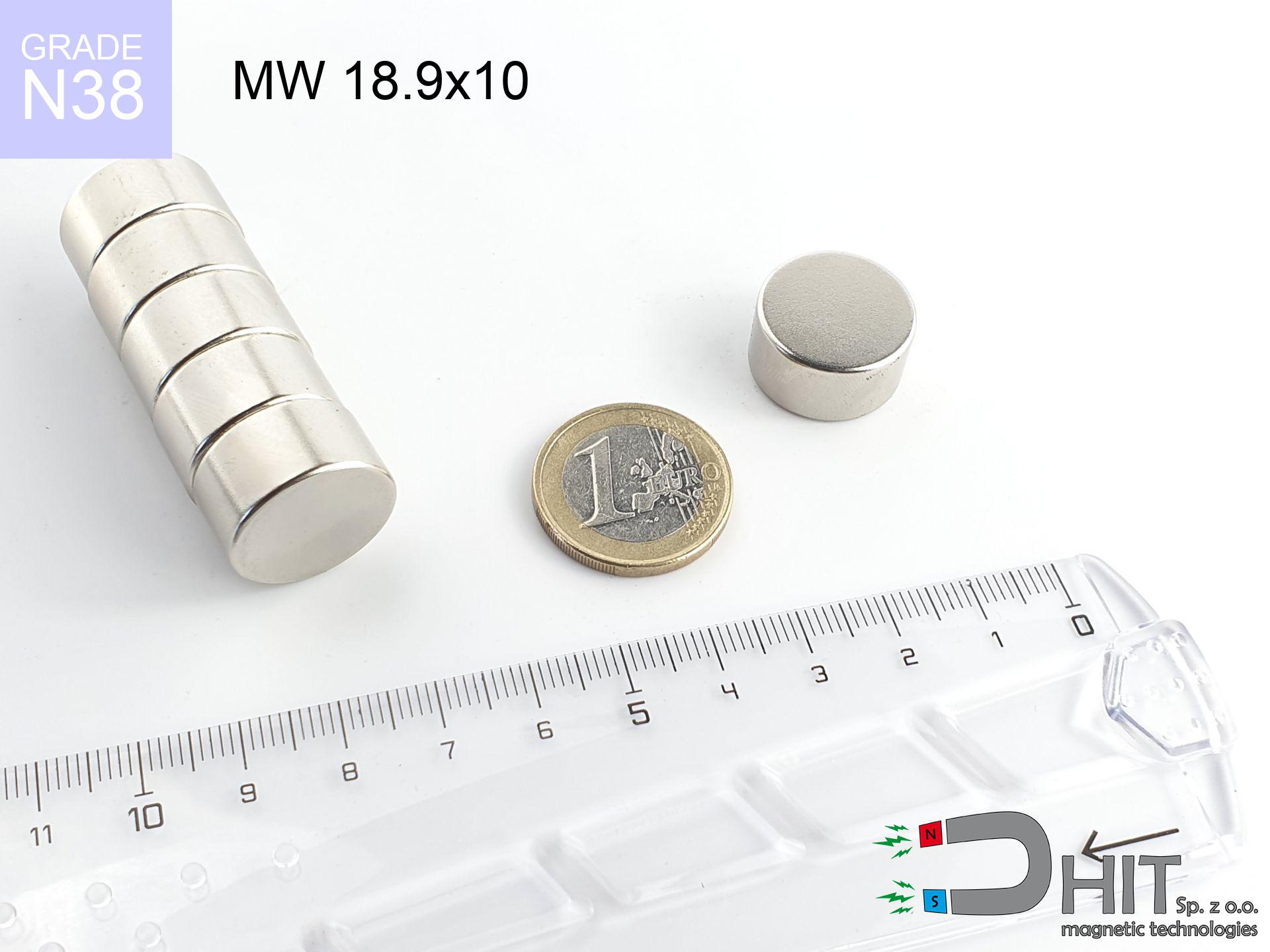MPL 25x2x6 / N38 - lamellar magnet
lamellar magnet
Catalog no 020509
length
25 mm [±0,1 mm]
Width
2 mm [±0,1 mm]
Height
6 mm [±0,1 mm]
Weight
2.25 g
Magnetization Direction
↑ axial
Load capacity
2.33 kg / 22.82 N
Magnetic Induction
558.90 mT / 5589 Gs
Coating
[NiCuNi] Nickel
0.713 ZŁ with VAT / pcs + price for transport
0.580 ZŁ net + 23% VAT / pcs
bulk discounts:
Need more?
Call us
+48 888 99 98 98
alternatively drop us a message through
request form
our website.
Parameters and structure of neodymium magnets can be reviewed on our
power calculator.
Same-day processing for orders placed before 14:00.
Technical data - MPL 25x2x6 / N38 - lamellar magnet
Specification / characteristics - MPL 25x2x6 / N38 - lamellar magnet
| properties | values |
|---|---|
| Cat. no. | 020509 |
| Production/Distribution | Dhit sp. z o.o. |
| Country of origin | Poland / China / Germany |
| Customs code | 85059029 |
| length | 25 mm [±0,1 mm] |
| Width | 2 mm [±0,1 mm] |
| Height | 6 mm [±0,1 mm] |
| Weight | 2.25 g |
| Magnetization Direction | ↑ axial |
| Load capacity ~ ? | 2.33 kg / 22.82 N |
| Magnetic Induction ~ ? | 558.90 mT / 5589 Gs |
| Coating | [NiCuNi] Nickel |
| Manufacturing Tolerance | ±0.1 mm |
Magnetic properties of material N38
| properties | values | units |
|---|---|---|
| remenance Br [min. - max.] ? | 12.2-12.6 | kGs |
| remenance Br [min. - max.] ? | 1220-1260 | mT |
| coercivity bHc ? | 10.8-11.5 | kOe |
| coercivity bHc ? | 860-915 | kA/m |
| actual internal force iHc | ≥ 12 | kOe |
| actual internal force iHc | ≥ 955 | kA/m |
| energy density [min. - max.] ? | 36-38 | BH max MGOe |
| energy density [min. - max.] ? | 287-303 | BH max KJ/m |
| max. temperature ? | ≤ 80 | °C |
Physical properties of sintered neodymium magnets Nd2Fe14B at 20°C
| properties | values | units |
|---|---|---|
| Vickers hardness | ≥550 | Hv |
| Density | ≥7.4 | g/cm3 |
| Curie Temperature TC | 312 - 380 | °C |
| Curie Temperature TF | 593 - 716 | °F |
| Specific resistance | 150 | μΩ⋅cm |
| Bending strength | 250 | MPa |
| Compressive strength | 1000~1100 | MPa |
| Thermal expansion parallel (∥) to orientation (M) | (3-4) x 10-6 | °C-1 |
| Thermal expansion perpendicular (⊥) to orientation (M) | -(1-3) x 10-6 | °C-1 |
| Young's modulus | 1.7 x 104 | kg/mm² |
Physical analysis of the magnet - report
These data are the outcome of a mathematical simulation. Values are based on algorithms for the material Nd2Fe14B. Real-world conditions might slightly differ from theoretical values. Use these calculations as a reference point for designers.
Table 1: Static pull force (force vs gap) - interaction chart
MPL 25x2x6 / N38
| Distance (mm) | Induction (Gauss) / mT | Pull Force (kg) | Risk Status |
|---|---|---|---|
| 0 mm |
5574 Gs
557.4 mT
|
2.33 kg / 2330.0 g
22.9 N
|
strong |
| 1 mm |
2599 Gs
259.9 mT
|
0.51 kg / 506.6 g
5.0 N
|
weak grip |
| 2 mm |
1392 Gs
139.2 mT
|
0.15 kg / 145.3 g
1.4 N
|
weak grip |
| 3 mm |
879 Gs
87.9 mT
|
0.06 kg / 58.0 g
0.6 N
|
weak grip |
| 5 mm |
454 Gs
45.4 mT
|
0.02 kg / 15.5 g
0.2 N
|
weak grip |
| 10 mm |
155 Gs
15.5 mT
|
0.00 kg / 1.8 g
0.0 N
|
weak grip |
| 15 mm |
72 Gs
7.2 mT
|
0.00 kg / 0.4 g
0.0 N
|
weak grip |
| 20 mm |
39 Gs
3.9 mT
|
0.00 kg / 0.1 g
0.0 N
|
weak grip |
| 30 mm |
15 Gs
1.5 mT
|
0.00 kg / 0.0 g
0.0 N
|
weak grip |
| 50 mm |
4 Gs
0.4 mT
|
0.00 kg / 0.0 g
0.0 N
|
weak grip |
Table 2: Vertical capacity (wall)
MPL 25x2x6 / N38
| Distance (mm) | Friction coefficient | Pull Force (kg) |
|---|---|---|
| 0 mm | Stal (~0.2) |
0.47 kg / 466.0 g
4.6 N
|
| 1 mm | Stal (~0.2) |
0.10 kg / 102.0 g
1.0 N
|
| 2 mm | Stal (~0.2) |
0.03 kg / 30.0 g
0.3 N
|
| 3 mm | Stal (~0.2) |
0.01 kg / 12.0 g
0.1 N
|
| 5 mm | Stal (~0.2) |
0.00 kg / 4.0 g
0.0 N
|
| 10 mm | Stal (~0.2) |
0.00 kg / 0.0 g
0.0 N
|
| 15 mm | Stal (~0.2) |
0.00 kg / 0.0 g
0.0 N
|
| 20 mm | Stal (~0.2) |
0.00 kg / 0.0 g
0.0 N
|
| 30 mm | Stal (~0.2) |
0.00 kg / 0.0 g
0.0 N
|
| 50 mm | Stal (~0.2) |
0.00 kg / 0.0 g
0.0 N
|
Table 3: Vertical assembly (shearing) - behavior on slippery surfaces
MPL 25x2x6 / N38
| Surface type | Friction coefficient / % Mocy | Max load (kg) |
|---|---|---|
| Raw steel |
µ = 0.3
30% Nominalnej Siły
|
0.70 kg / 699.0 g
6.9 N
|
| Painted steel (standard) |
µ = 0.2
20% Nominalnej Siły
|
0.47 kg / 466.0 g
4.6 N
|
| Oily/slippery steel |
µ = 0.1
10% Nominalnej Siły
|
0.23 kg / 233.0 g
2.3 N
|
| Magnet with anti-slip rubber |
µ = 0.5
50% Nominalnej Siły
|
1.17 kg / 1165.0 g
11.4 N
|
Table 4: Steel thickness (substrate influence) - sheet metal selection
MPL 25x2x6 / N38
| Steel thickness (mm) | % power | Real pull force (kg) |
|---|---|---|
| 0.5 mm |
|
0.23 kg / 233.0 g
2.3 N
|
| 1 mm |
|
0.58 kg / 582.5 g
5.7 N
|
| 2 mm |
|
1.17 kg / 1165.0 g
11.4 N
|
| 5 mm |
|
2.33 kg / 2330.0 g
22.9 N
|
| 10 mm |
|
2.33 kg / 2330.0 g
22.9 N
|
Table 5: Working in heat (material behavior) - power drop
MPL 25x2x6 / N38
| Ambient temp. (°C) | Power loss | Remaining pull | Status |
|---|---|---|---|
| 20 °C | 0.0% |
2.33 kg / 2330.0 g
22.9 N
|
OK |
| 40 °C | -2.2% |
2.28 kg / 2278.7 g
22.4 N
|
OK |
| 60 °C | -4.4% |
2.23 kg / 2227.5 g
21.9 N
|
OK |
| 80 °C | -6.6% |
2.18 kg / 2176.2 g
21.3 N
|
|
| 100 °C | -28.8% |
1.66 kg / 1659.0 g
16.3 N
|
Table 6: Magnet-Magnet interaction (repulsion) - field collision
MPL 25x2x6 / N38
| Gap (mm) | Attraction (kg) (N-S) | Repulsion (kg) (N-N) |
|---|---|---|
| 0 mm |
9.58 kg / 9579 g
94.0 N
5 924 Gs
|
N/A |
| 1 mm |
4.52 kg / 4521 g
44.3 N
7 659 Gs
|
4.07 kg / 4069 g
39.9 N
~0 Gs
|
| 2 mm |
2.08 kg / 2082 g
20.4 N
5 198 Gs
|
1.87 kg / 1874 g
18.4 N
~0 Gs
|
| 3 mm |
1.06 kg / 1059 g
10.4 N
3 708 Gs
|
0.95 kg / 953 g
9.4 N
~0 Gs
|
| 5 mm |
0.37 kg / 366 g
3.6 N
2 179 Gs
|
0.33 kg / 329 g
3.2 N
~0 Gs
|
| 10 mm |
0.06 kg / 64 g
0.6 N
909 Gs
|
0.06 kg / 57 g
0.6 N
~0 Gs
|
| 20 mm |
0.01 kg / 7 g
0.1 N
311 Gs
|
0.00 kg / 0 g
0.0 N
~0 Gs
|
| 50 mm |
0.00 kg / 0 g
0.0 N
46 Gs
|
0.00 kg / 0 g
0.0 N
~0 Gs
|
Table 7: Hazards (implants) - warnings
MPL 25x2x6 / N38
| Object / Device | Limit (Gauss) / mT | Safe distance |
|---|---|---|
| Pacemaker | 5 Gs (0.5 mT) | 5.0 cm |
| Hearing aid | 10 Gs (1.0 mT) | 3.5 cm |
| Mechanical watch | 20 Gs (2.0 mT) | 3.0 cm |
| Phone / Smartphone | 40 Gs (4.0 mT) | 2.0 cm |
| Remote | 50 Gs (5.0 mT) | 2.0 cm |
| Payment card | 400 Gs (40.0 mT) | 1.0 cm |
| HDD hard drive | 600 Gs (60.0 mT) | 0.5 cm |
Table 8: Impact energy (cracking risk) - warning
MPL 25x2x6 / N38
| Start from (mm) | Speed (km/h) | Energy (J) | Predicted outcome |
|---|---|---|---|
| 10 mm |
32.47 km/h
(9.02 m/s)
|
0.09 J | |
| 30 mm |
56.21 km/h
(15.61 m/s)
|
0.27 J | |
| 50 mm |
72.57 km/h
(20.16 m/s)
|
0.46 J | |
| 100 mm |
102.63 km/h
(28.51 m/s)
|
0.91 J |
Table 9: Coating parameters (durability)
MPL 25x2x6 / N38
| Technical parameter | Value / Description |
|---|---|
| Coating type | [NiCuNi] Nickel |
| Layer structure | Nickel - Copper - Nickel |
| Layer thickness | 10-20 µm |
| Salt spray test (SST) ? | 24 h |
| Recommended environment | Indoors only (dry) |
Table 10: Electrical data (Pc)
MPL 25x2x6 / N38
| Parameter | Value | SI Unit / Description |
|---|---|---|
| Magnetic Flux | 2 608 Mx | 26.1 µWb |
| Pc Coefficient | 0.76 | High (Stable) |
Table 11: Physics of underwater searching
MPL 25x2x6 / N38
| Environment | Effective steel pull | Effect |
|---|---|---|
| Air (land) | 2.33 kg | Standard |
| Water (riverbed) |
2.67 kg
(+0.34 kg Buoyancy gain)
|
+14.5% |
1. Sliding resistance
*Caution: On a vertical wall, the magnet retains just a fraction of its max power.
2. Steel saturation
*Thin metal sheet (e.g. 0.5mm PC case) severely limits the holding force.
3. Temperature resistance
*For standard magnets, the safety limit is 80°C.
4. Demagnetization curve and operating point (B-H)
chart generated for the permeance coefficient Pc (Permeance Coefficient) = 0.76
The chart above illustrates the magnetic characteristics of the material within the second quadrant of the hysteresis loop. The solid red line represents the demagnetization curve (material potential), while the dashed blue line is the load line based on the magnet's geometry. The Pc (Permeance Coefficient), also known as the load line slope, is a dimensionless value that describes the relationship between the magnet's shape and its magnetic stability. The intersection of these two lines (the black dot) is the operating point — it determines the actual magnetic flux density generated by the magnet in this specific configuration. A higher Pc value means the magnet is more 'slender' (tall relative to its area), resulting in a higher operating point and better resistance to irreversible demagnetization caused by external fields or temperature. A value of 0.42 is relatively low (typical for flat magnets), meaning the operating point is closer to the 'knee' of the curve — caution is advised when operating at temperatures near the maximum limit to avoid strength loss.
Elemental analysis
| iron (Fe) | 64% – 68% |
| neodymium (Nd) | 29% – 32% |
| boron (B) | 1.1% – 1.2% |
| dysprosium (Dy) | 0.5% – 2.0% |
| coating (Ni-Cu-Ni) | < 0.05% |
Sustainability
| recyclability (EoL) | 100% |
| recycled raw materials | ~10% (pre-cons) |
| carbon footprint | low / zredukowany |
| waste code (EWC) | 16 02 16 |
Other products
Strengths as well as weaknesses of rare earth magnets.
Advantages
- Their strength remains stable, and after around ten years it decreases only by ~1% (theoretically),
- Magnets effectively resist against demagnetization caused by foreign field sources,
- The use of an refined layer of noble metals (nickel, gold, silver) causes the element to be more visually attractive,
- Neodymium magnets achieve maximum magnetic induction on a small area, which allows for strong attraction,
- Due to their durability and thermal resistance, neodymium magnets are capable of operate (depending on the form) even at high temperatures reaching 230°C or more...
- Possibility of accurate shaping as well as adjusting to concrete needs,
- Versatile presence in modern industrial fields – they are utilized in HDD drives, drive modules, advanced medical instruments, and technologically advanced constructions.
- Thanks to concentrated force, small magnets offer high operating force, with minimal size,
Limitations
- At very strong impacts they can crack, therefore we recommend placing them in steel cases. A metal housing provides additional protection against damage and increases the magnet's durability.
- We warn that neodymium magnets can reduce their power at high temperatures. To prevent this, we suggest our specialized [AH] magnets, which work effectively even at 230°C.
- Magnets exposed to a humid environment can corrode. Therefore when using outdoors, we recommend using waterproof magnets made of rubber, plastic or other material protecting against moisture
- Limited possibility of producing threads in the magnet and complicated shapes - preferred is casing - magnet mounting.
- Possible danger related to microscopic parts of magnets pose a threat, when accidentally swallowed, which gains importance in the context of child safety. Furthermore, small components of these products can be problematic in diagnostics medical in case of swallowing.
- Due to expensive raw materials, their price is relatively high,
Lifting parameters
Detachment force of the magnet in optimal conditions – what it depends on?
- using a sheet made of mild steel, functioning as a magnetic yoke
- with a thickness no less than 10 mm
- with an polished touching surface
- with direct contact (no paint)
- under vertical force vector (90-degree angle)
- at temperature room level
Determinants of practical lifting force of a magnet
- Air gap (betwixt the magnet and the plate), since even a microscopic clearance (e.g. 0.5 mm) can cause a decrease in force by up to 50% (this also applies to varnish, corrosion or dirt).
- Loading method – declared lifting capacity refers to detachment vertically. When attempting to slide, the magnet holds much less (typically approx. 20-30% of maximum force).
- Plate thickness – insufficiently thick plate does not accept the full field, causing part of the power to be lost to the other side.
- Material type – the best choice is high-permeability steel. Stainless steels may have worse magnetic properties.
- Smoothness – full contact is possible only on polished steel. Rough texture reduce the real contact area, weakening the magnet.
- Thermal factor – hot environment reduces magnetic field. Exceeding the limit temperature can permanently damage the magnet.
Lifting capacity testing was carried out on a smooth plate of optimal thickness, under perpendicular forces, whereas under attempts to slide the magnet the holding force is lower. In addition, even a minimal clearance between the magnet’s surface and the plate lowers the lifting capacity.
Safety rules for work with neodymium magnets
Compass and GPS
Note: neodymium magnets produce a field that disrupts precision electronics. Keep a separation from your phone, device, and navigation systems.
Warning for heart patients
Life threat: Neodymium magnets can turn off pacemakers and defibrillators. Stay away if you have electronic implants.
Bone fractures
Protect your hands. Two large magnets will join immediately with a force of several hundred kilograms, crushing everything in their path. Be careful!
Thermal limits
Monitor thermal conditions. Heating the magnet above 80 degrees Celsius will ruin its magnetic structure and strength.
Nickel allergy
Allergy Notice: The Ni-Cu-Ni coating contains nickel. If an allergic reaction happens, immediately stop working with magnets and wear gloves.
Data carriers
Device Safety: Strong magnets can ruin payment cards and delicate electronics (pacemakers, medical aids, timepieces).
Fire risk
Combustion risk: Rare earth powder is explosive. Do not process magnets in home conditions as this may cause fire.
Do not underestimate power
Before starting, read the rules. Sudden snapping can destroy the magnet or hurt your hand. Think ahead.
Fragile material
Despite the nickel coating, neodymium is brittle and cannot withstand shocks. Do not hit, as the magnet may crumble into hazardous fragments.
Choking Hazard
Neodymium magnets are not toys. Eating a few magnets can lead to them pinching intestinal walls, which constitutes a severe health hazard and necessitates urgent medical intervention.








